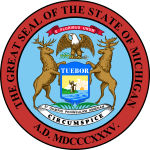
Back Histoire du Michigan French Historia de Míchigan Galician Միչիգանի պատմություն Armenian ミシガン州の歴史 Japanese История Мичигана Russian 密歇根州歷史 Chinese

| History of Michigan |
|---|
|
|
|
The history of human activity in Michigan, a U.S. state in the Great Lakes, began with settlement of the western Great Lakes region by Paleo-Indians perhaps as early as 11,000 B.C.E. One early technology they developed was the use of native copper, which they would fashion into tools and other implements with "hammer stones".[1][2] The first Europeans to arrive in Michigan were the French. Explorer Étienne Brûlé traveled through Michigan in 1618 searching for a route to China. Soon the French laid claim to the land and began to trade with the local natives for furs. Men called "voyageurs" would travel the rivers by canoe trading various goods for furs that would bring a high price back in Europe.
The first French explorer of Michigan, Étienne Brûlé, began in about 1620.[3] The area was part of French Canada from 1668 to 1763. In 1701, the French officer Antoine de la Mothe Cadillac, along with fifty-one additional French-Canadians, founded a settlement called Fort Pontchartrain du Détroit, now the city of Detroit. When New France was defeated in the French and Indian War, it ceded the region to Britain in 1763. After the British were defeated in the American Revolutionary War, the Treaty of Paris (1783) expanded the United States' boundaries to include nearly all land east of the Mississippi River and south of Canada. Michigan was then part of the "Old Northwest". From 1787 to 1800, it was part of the Northwest Territory. In 1800, the Indiana Territory was created, and most of the current state Michigan lay within it, with only the easternmost parts of the state remaining in the Northwest Territory.[4] In 1802, when Ohio was admitted to the Union, the whole of Michigan was attached to the Territory of Indiana, and so remained until 1805, when the Territory of Michigan was established.[5] Michigan was made the twenty-sixth state of the United States on January 26.
The opening of the Erie Canal in 1825 connected the Great Lakes with the Hudson River and New York City, and brought large numbers of people to Michigan and provided an inexpensive way to ship crops to market. In 1835 the people approved the Constitution of 1835, thereby forming a state government, although Congressional recognition was delayed pending resolution of a boundary dispute with Ohio known as the Toledo War. Congress awarded the "Toledo Strip" to Ohio. Michigan received the western part of the Upper Peninsula as a concession and formally entered the Union as a state on January 26, 1837.
When iron and copper were discovered in the Upper Peninsula, impetus was created for the construction of the Soo Locks, completed in 1855. Along with mining, agriculture and logging became important industries.[6] Ransom E. Olds founded Oldsmobile in Lansing in 1897, and in 1899 Henry Ford built his first automobile factory in Detroit. General Motors was founded in Flint in 1908. Automobile assembly and associated manufacturing soon dominated Detroit, and the economy of Michigan.
The Great Depression of the 1930s affected Michigan more severely than many other places because of its industrial base.[6] However, the state recovered in the post World War II years. The Mackinac Bridge connecting the Upper and Lower Peninsulas was completed and opened in 1957. By the 1960s, racial tensions produced unrest through the nation, and Detroit experienced a dramatic instance with the 12th Street Riot in 1967. By the 1980s, the state saw a decline in automobile sales and unemployment climbed. Michigan continues to diversify its economy away from its dependence on the automobile industry.
- ^ "Indians in the Great Lakes region".
- ^ Quimby, George Irving (1970). Indian Culture and European Trade Goods: The Archeology of the Historic Period in the Western Great Lakes Region, p. 15. University of Wisconsin Press.
- ^ Dunbar, Willis F. & May, George F. (3rd rev. ed. 1995). Michigan: A History of the Wolverine State, p. 19. Wm. B. Eerdmans Publishing Co.
- ^ Dunbar (1995), pp. 106–07.
- ^ Utley, Henry M. & Cutcheon, Byron M. (1906). Michigan as a Province, Territory and State: Michigan as a Territory, from Its Incorporation as Part of the Northwest Territory to Its Organization as a State, p. 138.
- ^ a b Daly, Matthew L., et al. (eds.) (2008). Michigan Encyclopedia, pp. 56–62. Somerset Publishers, Inc.